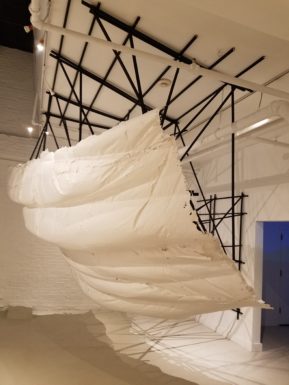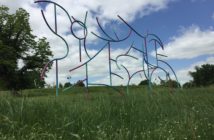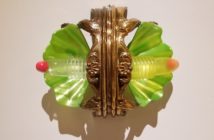Jesse Kaminsky, a Boston-based artist and DJ, makes work that oozes and crystallizes, and his radio show focuses on matters science fiction and the extraterrestrial. In his new exhibition, Scoped, on view at The Distillery Gallery through July 6, his sculptures and medium-scale installation center around science fiction, dream-based logic, and our world's existence in different scales and separate dimensions.
Naturally, that guiding philosophy raises more questions than it answers. Where did these worlds come from? What dimensions contain them? What does that mean for denizens of this world? Kaminksy’s exclusion of texts and titles further underscores the show’s ambiguity. Instead, he lets our subconscious, that network of tiny urges, guide our experience and interpretation.
On a weekday, the gallery is quiet. A calm, dream-like atmosphere emerges, with few points of orientation. Light and physical structure are key among them; light creates different dimensions to the work, and we are invited to ponder the composition of the installation as it hangs before us.
 Immediately, the careful lighting becomes a focal point.
Immediately, the careful lighting becomes a focal point.
The first piece to the right, modeled in wood and painted a delicate blue, is the first to illustrate the expansive and additive quality of the lighting. Four broad panels are set at oblique angles and seem to slide from the wall along a stretched plane, almost like an axonometric painting. The lighting extends this sliding effect. The shadows it casts veer to the bottom left. The angle is quite telling, for that style of painting seeks to render immediately intelligible an entire home or scene.
The last of the blue sculptures draws on some Josef Albers-esque color theory. Circles of varying blue shades litter the surface, stretching over the medallion shape’s edges and corners. The same careful lighting casts the beveled edges into shadow. It is initially difficult to discern whether the circles on the edges are indeed different hues. Perhaps it is a play of the light. Or perhaps approaching the piece as is takes priority.
 Were the sculptures cast in a more generalized gallery glow, I wouldn’t be so taken with the works. However, the lighting creates dimensions that stretch beyond the edge of the sculptures onto the wall itself, mirroring and expanding upon the material of the sculpture proper, bringing into questions where they begin and ends. Even though these extensions are not quite entire “recursive versions” of our own world, these geometric works do merge our knowledge of their physical reality, and Kaminsky’s way of altering that knowledge. The edges blur, as they would in a dream.
Were the sculptures cast in a more generalized gallery glow, I wouldn’t be so taken with the works. However, the lighting creates dimensions that stretch beyond the edge of the sculptures onto the wall itself, mirroring and expanding upon the material of the sculpture proper, bringing into questions where they begin and ends. Even though these extensions are not quite entire “recursive versions” of our own world, these geometric works do merge our knowledge of their physical reality, and Kaminsky’s way of altering that knowledge. The edges blur, as they would in a dream.
The intense focus that the art gives to lighting shifts gears. In the final chamber, eerie blue and green lights shine behind a second hull. It is similar to the first, but the shadows—which I’ve been giving artistic visual weight—point to a departure.
A network of vines and bouquets of flowers run between this work’s support and a grouping of inflated white bags. A fan can be heard running deep inside, keeping the work’s vascular system breathing. It is almost a living thing unto itself.
 It is at this point when the different dimensions from Kaminsky’s description manifest. Throughout the small show, he gives various looking strategies focusing on light, shadow, and tone. This could very well be a version of the previous piece spirited to our world, as it were.
It is at this point when the different dimensions from Kaminsky’s description manifest. Throughout the small show, he gives various looking strategies focusing on light, shadow, and tone. This could very well be a version of the previous piece spirited to our world, as it were.
Though that is not to say that description is central the installation. In my private correspondence with Kaminsky, he gave a more elaborate point of inspiration—a waking dream he experienced in which a party contacted another through a top-tier microscope and various radiation sensors. Ultimately, the exclusion of this background was a pragmatic one. The dream, as he describes it, was a starting point. He didn’t want to pigeonhole the work or limit the audience’s interpretive powers and possibilities.
Each visitor who has viewed work will experience their own vision; I prioritized lighting, but another may prioritize shading and color. And that is the appeal of a showing such as this one. His sculpture is our shared mutual experience—a launching pad for a varied mental murmurations. Without the overhead guidance of texts, we are liberated to create our own interpretive dimensions where the work resides and creates myriad meanings.




